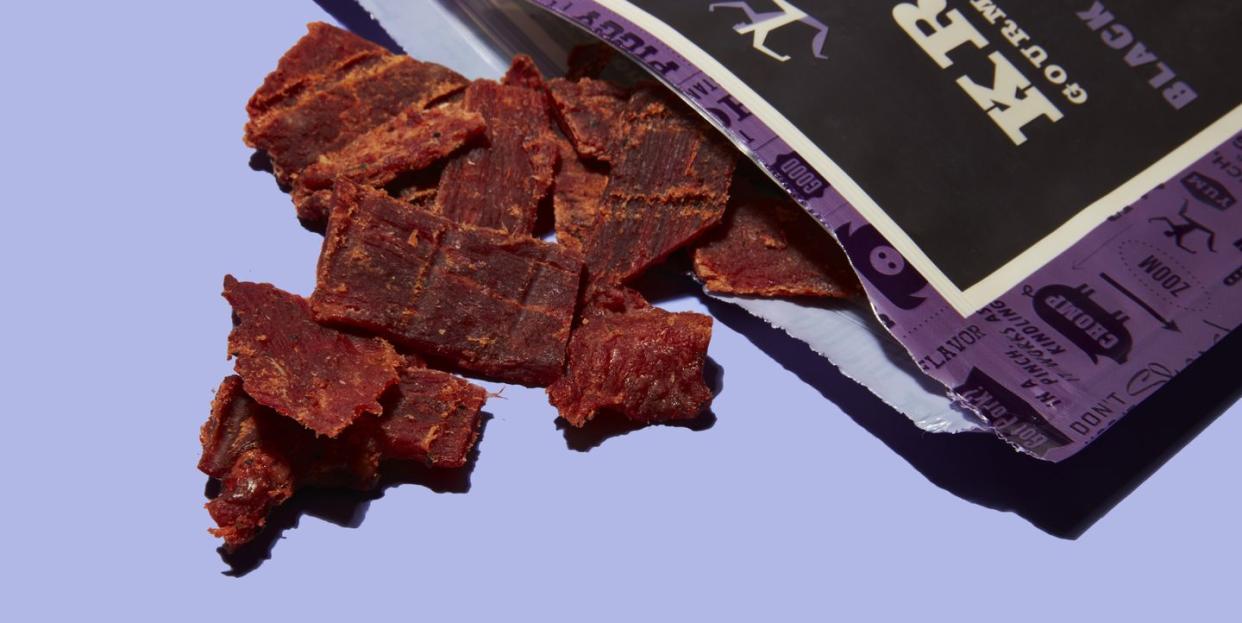Is Beef Jerky Actually a Healthy Snack?

When mid- or postride options are limited to gas station snacks, many of us just grab a bag of beef jerky to go. Jerky is a high-protein pick, defined as having a moisture-to-protein ratio of 0.75 to 1 or less, and it has become increasingly popular over the years, especially as high-protein, low-carb diets have grown in popularity.
But like any food that’s billed as a “health” food, we had some questions. Is beef jerky really healthy? What about turkey or pork varieties? How much jerky is too much jerky? So we tapped New York-based dietitians Kelly Hogan, M.S., R.D., and Natalie Rizzo, M.S., R.D., to weigh in on what’s what when it comes to your favorite dried meat snack.
The Claim:
Jerky—beef, turkey, pork, to name a few—is a healthy snack due to its protein content, which can help fuel your rides and recovery.
The sodium content in jerky, thanks to its curing process, may also help you restock your electrolytes after a hot and humid ride.
But, as Hogan and Rizzo point out, there are certain ingredients that can quickly turn a healthy jerky snack in something artificial and packed with sodium.
The Evidence:
Let’s take a closer look at the nutrition of a no-frills beef jerky from Country Archer.
Serving size: 1 ounce
Calories: 70 calories
Fat: 1 gram
Saturated fat: 0 grams
Protein: 9 grams
Carbohydrates: 6 grams
Sugar: 4 grams
Sodium: 400 milligrams
Any time you’re snacking on meat, you’re going to get a good amount of protein, which is crucial for athletes. A 1-ounce serving of jerky, for example, has about 9g of protein.
But jerky is created through the curing process, which requires the addition of salt to draw out moisture. Once meat has been properly dehydrated, it’s no longer susceptible to spoilage because that new environment makes it difficult for microbe growth. But that addition of salt makes jerky a high-sodium food.
“Jerky is super high in sodium,” Hogan says. “While that can be beneficial for an endurance athlete losing a lot of salt through sweat, it might not be a great choice for someone with high blood pressure or any sort of kidney disease.”
Plus, Rizzo says, salt is in just about everything we eat throughout the day. You don’t want a quarter of your salt intake to come from one sitting. The American Heart Association recommends not consuming more than 2,300 mg of sodium per day, but ideally, people would limit their intake around 1,500 mg.
Depending on the brand and flavor, a 1-ounce serving of jerky has about 300-400 mg of sodium.
Otherwise, the ingredients, Rizzo says, should be simple. “Generally, jerky was made back when people were drying beef because they didn’t have the technology to preserve it,” she says. “It was a healthy snack. Artisanal and gourmet jerky [makers] today are still doing that. It’s dehydrated meat with some seasoning, so if that’s what you’re eating, then yes, that’s a healthy, protein-rich snack.”
But Rizzo goes on to point out that jerky brands like Slim Jim have questionable ingredients, including mechanically separated chicken, soy flour, corn syrup, and can make up 25 percent of your daily salt intake.
Sugar is often added to jerky flavors, and perhaps unsurprisingly, the sweeter the flavor—honey chipotle, anyone?—the more added sugar the jerky has. But, Rizzo says, meat does not have any carbohydrates, so even a few grams of sugar—fewer than 8 grams—is okay, especially during or after a ride when you need carbs to restock your muscle’s glycogen stores.
When it comes to choosing your jerky, saturated fat content is something to think about, Rizzo and Hogan say. Pork and beef, for example, will have slightly higher amounts of saturated fat than, say, turkey or chicken jerky.
Something else to consider in the health of your jerky is the use of nitrates in the curing process. Nitrates are also found in processed deli meats and hot dogs. Gourmet and artisanal jerky brands often tout “no added nitrates” except for what comes from salt and celery seed, which may be a good thing, according to a 2018 study published in Molecular Psychiatry. Researchers found that nitrates may contribute to mania—a mood state of hyperactivity, euphoria, and insomnia. It’s worth noting, however, that the study was not designed to look at cause and effect, and the researchers did not ask about frequency or the time frame of cured meat consumption.
The Verdict:
Jerky can be a healthy, tasty, and filling high-protein snack that will get you through your workout and recovery. But, it can also be an option that features questionable ingredients or hidden sugars. Find a jerky that’s made with wholesome ingredients—meat and seasoning—with, ideally, no artificial ingredients.
If refueling with a couple servings of jerky, Hogan and Rizzo recommend pairing with carbohydrates like crackers or a piece of fruit.“If you have a heavy training load, jerky as a snack is good for protein, but if you’re feeling sluggish, add a carbohydrate, too,” Hogan says. Think: crackers or some bread.
[Download the All Out Studio App for more amazing at-home workouts!]
And remember: Not all dried meats are technically jerky, which have that .75 to 1 moisture-to-protein ratio. Meat bars, for example, are dried meat but not technically jerky because of the moisture content. That’s not necessarily a bad thing, but jerky may have a slightly better ring to it than meat bar.
You Might Also Like

